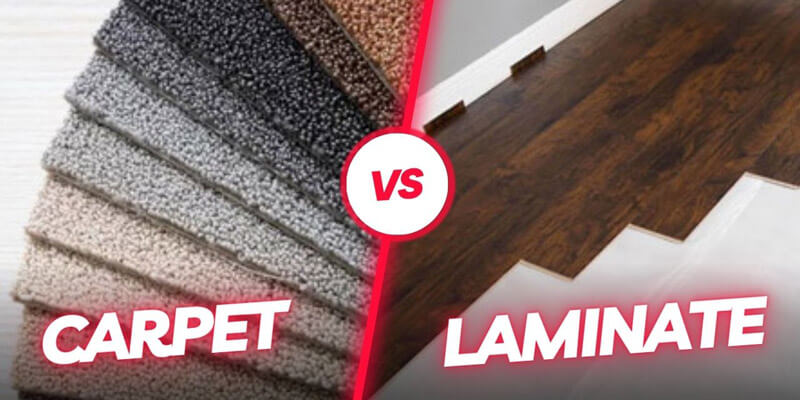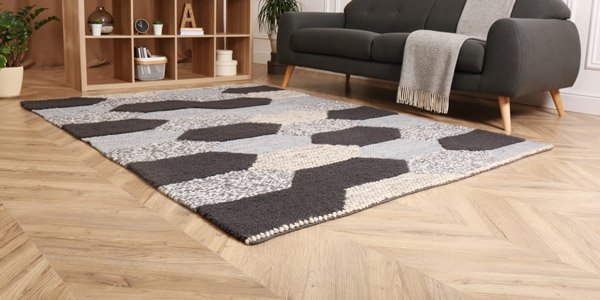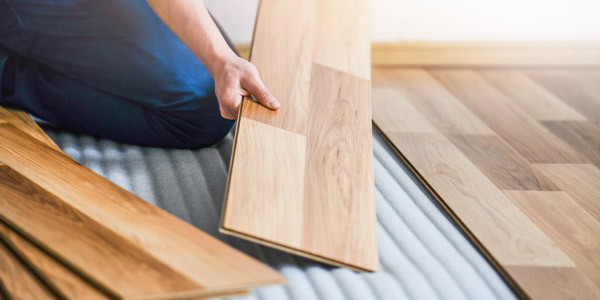There are several factors to consider before choosing a type of flooring for your home. If you live in a noise-prone area or want to keep your business as private as possible, consider a floor option with soundproofing properties.

If that’s the case, your options boil down to the two most debated flooring types – carpet and laminate. While the formal is better at dampening loud external noises than laminated floors, durability is a concern.
Which is better – carpet or laminate floors?
Read on to find out their key advantages, disappointing downsides, and, most importantly, who to get the most out of these options.
Carpet vs. Laminate: Which is Better for Soundproofing
Carpet and laminate with an underlayment are great options for canceling out noise and improving your room’s acoustics. However, each option has its own compelling benefits and worth-knowing downsides to ensure you make an informed decision.
Without further ado, let’s dive into them.
Interesting Carpet Benefits for Soundproofing
Carpets are highly sought after for their impressive protective property. They are commonly used as an extra protective layer to existing flooring – hardwood, vinyl, or laminate.
That’s not all: carpets are great at soundproofing impact and airborne noise. So, they are often used in highly trafficked areas to muffle those footfall noises for fewer distractions.
Also, they can help attenuate airborne noises from loud music, ongoing construction nearby, or next-door battering. You can get better soundproofing results with wool carpets. Thanks to their varying fiber length and size, wool carpets absorb sound waves of different frequencies.
Furthermore, you can improve your home’s soundproofing by doubling the carpet. This works just as well as placing underlayments or thick pads under the carpets.
On top of that;
Carpets, in addition to their fantastic ability to cancel out noise, offer impressive thermal insulation and a comfortable, slip-free surface to walk on.
How to Get the Most Out of Your Carpet?
Using underlayments is an effective option if you want to get the maximum noise-reduction performance. However, it’s essential to choose the right pads for maximum efficiency.

Here is how to choose the best underlayment to improve your carpet soundproofing result:
Thickness
When it comes to soundproofing, the mass of the material plays a crucial part in noise reduction. So, it’s a no-brainer that thicker pads will deliver more significant soundproofing results. However, purchasing a thick pad can be challenging to install and might affect your walking experience on the carpet.
STC & IIC Ratings
Before purchasing a pad, you should not ignore its soundproofing ratings. This gives you an insight into how much noise the material can cancel out.
The general rule of thumb is that pads with the highest STC rating offer maximum noise-isolation results. If you need to know what STC is, it’s a rating system that indicates the effectiveness of a material at reducing sound transmission through it.
Also, it would help to consider the IIC, which stands for impact insulation class. It’s another valuable metric for knowing how much impact the material can absorb. Similarly, it would be best if you aimed to purchase a pad with the highest IIC rating to dampen footsteps, banging, and other annoying impact noises.
Quick Tip: not every pad comes with this useful information on its label. So, it’s important to stick with thicker and heavier pads for maximum noise-isolation performance.
Soundproofing with Carpets? The Downsides
Carpets are essential for a soundproof home. However, it’s crucial that you pay attention to these drawbacks as it might be a terrible deal breaker for you.
To start with, carpets are prone to stains which you might find exhausting to keep a clean, pristine surface. They are not easy to clean like other floorings. If you have a stuffy room, you would have to move every piece whenever you want to clean your carpet thoroughly.
In addition to that, carpets are not the most durable flooring option. They usually are short-lived because they get damaged easily. If you mistakenly drag a piece of furniture like a stool, you’ve likely just ripped your expensive carpet.
Laminate Flooring & Its Benefits
For many years, laminate flooring has been the go-to for residential homes. It’s highly sought after for two main reasons – affordability and aesthetics.
Laminate flooring is one of the most affordable options, costing less than $5 per square foot to install on your residential home. Unlike carpet and other floorings, laminate is cheaper to maintain – thanks to its scratch and water-resistant attributes.
What’s more?
Homes with laminate flooring look classy and contemporary. It brings that authentic hardwood look to your space without requiring the hefty upfront price. While its laminate flooring is not the only option that offers a wooden appearance, it’s cheaper and has a smooth surface. Plus, you can easily customize this floor option to suit your home decor.
Sadly, laminate flooring does not do much to protect you from external noise. However, it doesn’t mean it’s useless for soundproofing.
How to Use Laminate Flooring for Noise Reduction?
Many homeowners choose this type of flooring for various reasons, except for soundproofing. However, if you install it on an underlayment, you can enjoy the benefits of both worlds.

It’s important to note that even with an underlayment, you won’t achieve the same level of soundproofing as carpet. Nonetheless, it can still help to muffle loud noises that tend to travel.
Adding a thin layer of felt, rubber, fiber, or foam can effectively absorb more noise while making the flooring more durable and resistant to wear and tear.
Installing underlayment is not so different from using pads with carpets. You can easily pull this feat off with zero issues if you consider yourself handy.
Carpet vs. Laminate
It is hard to say which of these two top flooring options wins regarding soundproofing. It really comes down to what benefits you prioritize and the level of soundproofing you want.
Performance
By now, you should know carpet is the clear winner for soundproofing. Laminate flooring requires underlayment to achieve the desired results.
Carpet is an excellent choice for residential and commercial spaces. This floor isolates impact and airborne noises with an extra layer of thick pads.
Durability and Cost
Most homeowners lend toward carpets because of their cheap upfront costs. With time, they realized this floor option was less cost-effective than they thought.
They are not as durable as laminate flooring, which requires low maintenance to keep in good condition for decades. Besides, cleaning a carpet can be exhausting. So, laminate flooring is more suitable for busy spaces.
Both flooring are easy to install. But it’s important to keep laminate away from water-prone areas.
Conclusion
Is carpet or laminate better for soundproofing? If you want to effectively stop the annoying external noise in a less trafficked space, then carpet is a great choice. You can add some thick pads to improve its noise reduction capabilities.
On the other hand, laminate flooring is the best choice for commercial spaces. They are more durable and easy to maintain. However, you would have to purchase underlayment to ensure it blocks out some noise.
There’s no going wrong with any of these flooring options. They will help soundproof your home and improve the room’s acoustics.
Related Resources:
